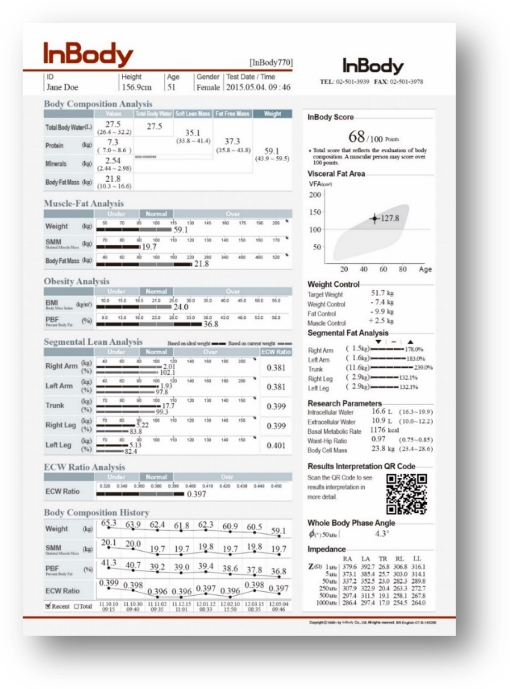The Clinical Team of InBody Europe explore the connection between body composition and diabetes
The body needs a balance of lean body mass (LBM) and fat mass to function optimally and maintain positive health. However, this balance can be disrupted in overweight and obese individuals because of excess fat.
Most people think the goal for overweight individuals should be to lose weight. But this mindset overlooks a larger and more important picture. Overweight individuals should focus on improving body composition by reducing fat mass while maintaining or increasing LBM.

Better-balanced body composition can reduce your risk of diabetes and other obesity-related disorders – and it can have a positive effect on your metabolism.
Metabolism refers to the breaking down of foods to supply energy for the maintenance and repair of current body structures. When you consume food, your body breaks it down into its elemental components and then directs each piece to where it needs to go.
But diabetes is a metabolic disorder – meaning the way it changes your body makes use of the nutrients in food, in such a way that your cells cannot use digested glucose for energy.
How? It all comes back to insulin. Without access to insulin, glucose cannot get into your cells, so it ends up lingering in your bloodstream. When the glucose cannot make its way out of the bloodstream, it will build up. All that excess blood sugar may then be converted to triglycerides and stored as fat. And with this increase in fat mass, hormone imbalances or systemic inflammation may occur or persist, increasing the risk for many other diseases or conditions.

A build-up of fat and diabetes are both associated with increased risk for heart attacks, stroke, kidney disease, nerve damage, skin infections, and eye problems. Diabetes can even result in an impaired immune system, which, combined with poor circulation to the extremities, increases the risk of wounds and infections, sometimes even leading to amputation of the toes, foot, or leg(s). In far too many cases, diabetes creates complications that eventually lead to death.
Why the location of body fat can increase your risk
Your fat can be stored subcutaneously or viscerally, also known as subcutaneous adipose tissue (SAT) and visceral adipose tissue (VAT). Subcutaneous fat lies under the skin, is pinchable and visible. It is also the fat that you generally see changes when you improve your body composition with cardiovascular and resistance training.
Defining visceral fat is straightforward: it is excess intra-abdominal fat. VAT cannot always be seen directly. But below the surface, it wraps itself around major organs, making it more dangerous to your health. VAT is more strongly associated with metabolic syndrome and diabetes than subcutaneous fat.
Recently, a study was released that focused on the role that visceral fat mass plays in type 2 diabetes. Part of their findings showed correlations between various body measurements and the risk for diabetes/prediabetes:
That orange line designates visceral fat, and it proved to be the single best predictor of both conditions.
The interesting thing about visceral fat is that it actively contributes to the state of our health because it acts like an organ in your body. Instead of contributing to your health like most organs, however, it actively works against it. This is because visceral fat produces cytokines, protective substances that are secreted by your immune system, however, excess cytokine production causes inflammation and increases the risks of cardiovascular disease, and negatively affects the cells’ sensitivity to insulin, further contributing to diabetes.

With fat cells, size matters in VAT’s case. Metabolic issues related to obesity were related to changes in fat cell size instead of fat cell number. Those with higher visceral fat were found to have enlarged fat cells, creating a greater propensity for those large fat cells to keep growing. Enlarged fat cells can increase the cell’s secretion of inflammatory cytokines, which may explain the link between obesity and insulin resistance.
What contributes to the increase of visceral fat? While your gender and genetics have an influence, a sedentary lifestyle with a lack of physical activity, a poor diet with excess calories from processed foods high in saturated fat and carbohydrates, stress, smoking, and poor sleep habits all highly contribute to your disease risk.
The connection between lean body mass and diabetes
Many are already aware of this connection between high-fat mass and diabetes. However, researchers have recently focused on another aspect of body composition as it relates to diabetes risk: Lean Body Mass. Many studies have already shown strong links between Type 2 Diabetes (T2D) and low lean body mass.
A large component of our LBM is our skeletal muscle mass – the muscles used for posture and movement. Unfortunately, diabetes is not only more common in those with less muscle, but it can also have negative effects on existing muscle. There are three main muscle characteristics that Type 2 Diabetes affects: fatigability, strength, and mass.
What is muscle fatigability?
Muscle fatigability refers to the rate at which your muscles become weaker after exercise or movement, and the time it takes for them to recover or return to their full power.
Researchers have known for years that muscle fatigability increases with T2D. When people with T2D perform an exercise, their muscles lose power faster than those of a healthy person’s T2D reduces overall muscle strength. Even after adjusting for age, sex, education, alcohol consumption, lifetime smoking, obesity, and aerobic physical activity, people with T2D had less handgrip strength than people without it.
Not only do Type 2 diabetes patients have both reduced muscle recovery and strength, but they also start to lose muscle mass. The longer you have diabetes, the more muscle mass you tend to lose, especially in the legs.
As you can see, the raised blood glucose levels caused by diabetes and insulin resistance puts your muscles at a disadvantage for several reasons.
Would you like to know your body composition?
See what you’re made of, with InBody.
*Please note: This is a commercial profile











